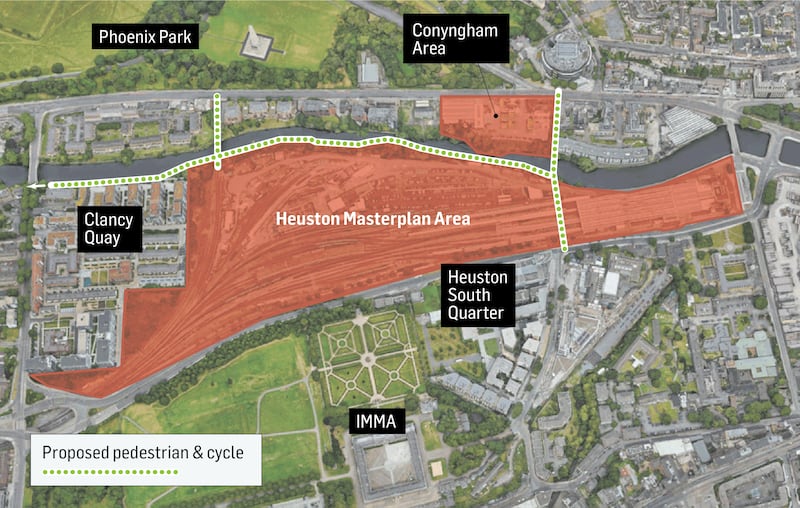Heuston Station, one of the State’s largest transport hubs, presents an impressive façade, with its original 1840s building based on the design of an Italian palazzo. However, this elegant exterior hides acres of underused and inaccessible space, dominated by surface car parking, storage sheds, and maintenance yards, right alongside, but with no connection to, what should be the area’s greatest asset: the River Liffey.
Dublin City Council has long aspired to create a residential “quarter” around Heuston to provide a gateway to the city, and define the town’s western end as a counterweight to the docklands at the Liffey’s east end. However, while, almost every docklands site has been built out, around Heuston, several sites remain vacant and some derelict.
Developments that have been completed are disjointed and isolated from each other, and the station. Clancy Barracks at Island Bridge, home to more than 800 apartments built over the past decade or so, and other nearby developments such as Heuston South Quarter are close to the platforms, but cut off by busy roads and the station’s own backlands.
Two years ago, State transport company CIÉ published the Heuston Masterplan to finally address these issues. It envisaged new access points to the station from the west at Clancy Quay, the south from St John’s Road and, most strikingly, from the north, with new bridges across the Liffey.
READ MORE

There would also be cycle and footpaths along the riverside, all serving to open up the station, not only to commuters and surrounding residents, but to its own new population, with plans for 1,000 apartments on the station’s lands.
“If we look at the CIÉ portfolio of lands, Heuston Station would be the jewel in the crown,” says Lorcan O’Connor, chief executive of the semi-State transport company.
“It’s the main intercity train station, Luas is there, a couple of BusConnects corridors going by. From an amenity perspective you’ve got the Phoenix Park on your doorstep, the river, and it also ticks the box for your 15 minutes city, you can cycle to pretty much anywhere in the city within 15 minutes.” It is, however, constricted in terms of access.
Done right you can have high-quality accommodation close to amenities that justifies higher densities than you would typically see
— Lorcan O’Connor, chief executive of CIÉ
“One of its weaknesses is that it has a single point of entry, in effect it’s a cul-de-sac. So, if you’re coming from the Phoenix Park or you’re living in Clancy Quay, as the bird flies you’re right beside the platform but if you want to walk, you have a very long distance to the front of Heuston to get back in – the same if you’re coming from Kilmainham,” says O’Connor.
The station’s development lands are also hampered by this single point of entry, a narrow road running alongside the river, currently used to access the station’s car park and the works buildings and yards to the west of the platforms, where the bulk of new development will be located.
There will be a mix of uses, with some office, retail and hotel use towards the main station end of the site, “but the biggest element would be residential”, O’Connor says, concentrating on the western end development close to Clancy Quay.
The nature of the site dictates development will be high density, though for the most part not high rise. While the heights of individual blocks will be determined in the later planning stages, the master plan envisages a prevailing height of six stories with one taller landmark building towards the eastern end of the site.
“Done right you can have high-quality accommodation close to amenities that justifies higher densities than you would typically see. That does not mean lesser quality, I am at pains to say,” says O’Connor. The development would also be a “car free” he says “that is a key feature for us”.
However, to make all this viable, the permeability of the site must be increased.
“We would envisage a cycle and pedestrian walkway all the way along the Liffey from the front of Heuston through the Clancy Quay development and then onward to the War Memorial Gardens,” he says.

While that provides the east-west connection, moving north-south across the river will require bridges. The most impressive of these is a proposed pedestrian and cycle bridge from the entrance to the Phoenix Park by the side of Conyngham Road bus garage over the river to the station’s platforms, then onwards across St John’s Road. This would link Heuston South Quarter, the Irish Museum of Modern Art and wider Kilmainham area, not only to the station, but right the way through to the Phoenix Park.
Another Liffey pedestrian and cycle bridge from Conyngham Road, where the Phoenix Park tunnel line enters the station, will allow access to the western end of the site and a planned new Dart station.
Conyngham Road bus garage is expected to accommodate at least a quarter of the 1,000 apartments. This is one of several Dublin bus garages CIÉ has long been under pressure to surrender for housing and looks set to be the first to move, though this could take up to five years, says O’Connor.
It makes sense that this would be the beginning of your real city centre, right through to the docklands on the other end of the Liffey
— Lorcan O’Connor, chief executive of CIÉ
The garage is not the only property CIÉ owns on Conyngham Road. A row of Victorian houses running east from the entrance of the garage has been allowed to degenerate into complete dereliction. “They are in need of rectification,” O’Connor admits.
That may mean their demolition. “We are liaising in Dublin City Council in relation to those. That could be the opportunity for the bridge to land at the entrance to the Phoenix Park.”
CIÉ published its masterplan in November 2021, and at that point intended to submit a planning application in 2023. However, that hasn’t happened and the project is considerably behind that timescale. A developer to build the whole scheme is still another year away from being appointed, O’Connor says.
“By the end of next year we will go to market for a joint-venture partner and would hope the year after that there will be a planning application.”
He partly blames Covid for this delay, but also cites the uncertainty around apartment construction viability.
“We feel next year is a point in time that we can go to the market with clarity round our timelines. We will be able to tell the market exactly when the various pieces of land will be releasable, and we will be able to stand firm around those timelines,” he says.
CIÉ hasn’t been “sitting on our hands” in the two years since the master plan was published, he says. It has been working with the council, modelling the impact of development and working with the National Transport Authority on the planning around the new bridges, cycle parking and the walkway along the river.
“We’ve also done a lot of work around finding alternative accommodation with the staff who are currently within the Heuston yard, as well as the work around sourcing the alternative for the Conyngham Road bus garage,” he says.
O’Connor remains confident the project will be completed over the next decade, creating a “book end to the city” and “a counterweight to all that’s happening in the docklands”.
“It makes sense that this would be the beginning of your real city centre, right through to the docklands on the other end of the Liffey,” he says.
He also believes this riverside quarter will ultimately be “a very attractive place to live”.
Tomorrow: Conor Lally looks at crime on the boardwalk along the LIffey in Dublin city centre and talks to the architects who designed it and their regrets on how it turned out













